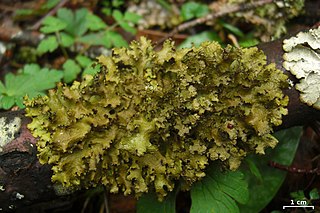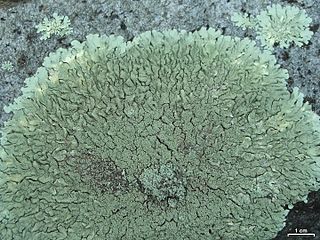
Cetraria is a genus of fruticose lichens that associate with green algae as photobionts. Most species are found at high latitudes, occurring on sand or heath, and are characterised by their "strap-like" form with spiny lobe edges. The lobes can range from narrow and linear to broader and flattened, often forming loose or densely packed cushions. Their distinctive spiny margins serve both a defensive role and aid in vegetative reproduction through fragmentation. The genus was created by Erik Acharius in 1803 and belongs to the large family Parmeliaceae. While originally a species-rich genus, taxonomic revisions since the 1960s have split many species into new genera, though the exact circumscription remains debated among lichenologists.

Arctocetraria is a genus of fruticose lichens in the family Parmeliaceae. It has three species.

Vulpicida is a genus of lichenized fungi in the family Parmeliaceae. Circumscribed in 1993 to contain species formerly placed in Cetraria, the genus is widespread in Arctic to northern temperate regions, and contains six species. The genus is characterized by the presence of the secondary metabolites pulvinic acid and vulpinic acid, compounds that when combined with usnic acid, give the species their characteristic yellow and green colors.

Tuckermannopsis is a genus of foliose lichens in the family Parmeliaceae.

Xanthoparmelia is a genus of foliose lichens in the family Parmeliaceae. This genus of lichen is commonly found in the United States, South America, southern Africa, Europe, Australia, and New Zealand.

Esslingeriana is a fungal genus in the family Parmeliaceae. The genus is monotypic, containing the single foliose lichen species Esslingeriana idahoensis, commonly known as the tinted rag lichen. It is found in northwestern North America.

Lichens are symbiotic organisms made up of multiple species: a fungus, one or more photobionts and sometimes a yeast. They are regularly grouped by their external appearance – a characteristic known as their growth form. This form, which is based on the appearance of vegetative part of the lichen, varies depending on the species and the environmental conditions it faces. Those who study lichens (lichenologists) have described a dozen of these forms: areolate, byssoid, calicioid, cladoniform, crustose, filamentous, foliose, fruticose, gelatinous, leprose, placoidioid and squamulose. Traditionally, crustose (flat), foliose (leafy) and fruticose (shrubby) are considered to be the three main forms. In addition to these more formalised, traditional growth types, there are a handful of informal types named for their resemblance to the lichens of specific genera. These include alectorioid, catapyrenioid, cetrarioid, hypogymnioid, parmelioid and usneoid.

Cetraria aculeata or the spiny Iceland lichen is a dark brown to black fruticose, soil Iceland lichen from the family Parmeliaceae. The species was first described by German naturalist Johann Christian Daniel Edler von Schreber in 1771 under the name of Lichen aculeatus. Later on, Erik Acharius, the "father of lichenology" gave it a name of Cornicularia aculeata, which lately has been changed to Coelocaulon aculeatum. Finally, the taxonomic revision of Ingvar Kärnefelt and colleagues assigned the species to the genus Cetraria.

Niorma hosseusiana is a species of corticolous (bark-dwelling), fruticose lichen in the family Teloschistaceae. It is found in South America.
Schaereria bullata is a species of lichen in the family Schaereriaceae. It is found in the alpine regions of Tasmania, Australia. This lichen species is characterized by its dark brown to grey-brown thallus, which forms irregular patches over soil or bryophytes, and consists of granules that coalesce to create convex to bullate squamules. The lichen also features distinctive apothecia, which are roundish and typically superficial, and spherical spores.
Filsoniana australiensis is a species of saxicolous (rock-dwelling), crustose lichen in the family Teloschistaceae. It is found in Australia. The lichen forms patches up to 9 cm wide, with dull pink to brownish pink lobes and a verrucose central area. It has distinctive, raised reddish-orange apothecia.
Menegazzia endocrocea is a species of foliose lichen in the family Parmeliaceae. It is found in Australia. The lichen forms irregular rosettes up to 10 cm wide with hollow, cylindrical lobes that branch dichotomously, featuring a pale grey to cream-grey upper surface with roundish holes and a wrinkled, black lower surface. It has scattered apothecia with a reddish-brown disc, two-spored asci, and abundant pycnidia, identified chemically by compounds like atranorin and stictic acid.

Pseudocyphellaria haywardiorum is a species of corticolous (bark-dwelling), foliose lichen in the family Peltigeraceae. It is found in New Zealand, where it is considered "at risk" under the New Zealand Threat Classification System. Pseudocyphellaria haywardiorum has a more or less circular thallus measuring 30–80 mm in diameter, loosely attached from its edges to its centre, featuring rising wavy margins with rounded lobes that overlap in a complex pattern. The upper surface varies in colour from dark grey-blue to brown-black, becoming darker at the lobe tips when moist, and displays a spectrum of colours including dark olive-brown to pale yellowish with greyish edges when dry, while the underside is either bubbly or unevenly wrinkled with a tomentum ranging from red-brown to black-brown, and white pseudocyphellae especially noticeable in the central region.

Tuckermannopsis orbata, commonly known as the variable wrinkle lichen, is a species of foliose lichen in the family Parmeliaceae. It is a small cetrarioid lichen, an informal growth form category that denotes lichens with erect, foliose thalli, and apothecia and pycnidia on the margins of the ruffled lobes. Tuckermannopsis orbata is found in Asia and North America, growing primarily on the wood and bark of mostly birch and coniferous tree branches and twigs.

Tuckermannopsis ciliaris is a species of corticolous (bark-dwelling), foliose lichen in the family Parmeliaceae. It was first described by Erik Acharius in 1810, initially classified in the genus Cetraria. The species was later reclassified into the genera Nephromopsis and then Tuckermannopsis, with some researchers proposing that certain cetrarioid genera, including Tuckermannopsis, should be merged into Nephromopsis. However, this suggestion was disputed, and both names, Tuckermannopsis ciliaris and Nephromopsis ciliaris, are used in recent literature to refer to this species.

Cetraria arenaria, commonly known as the sand-loving Iceland lichen, is a species of terricolous (ground-dwelling), fruticose lichen in the family Parmeliaceae. It was formally described as a new species in 1977 by the Norwegian lichenologist Ingvar Kärnefelt. The type specimen was collected in 1949 by Henry Imshaug from Mackinac County, Michigan, where he found it growing on sandy soil.
Roccellinastrum flavescens is a rare species of fruticose lichen in the family Pilocarpaceae. It is found only in the Walls of Jerusalem National Park in Tasmania, Australia. This pale yellow, shrub-like lichen grows exclusively on the twigs of pencil pine, a rare Tasmanian conifer. Described by Australian scientist Gintaras Kantvilas in 1990, it can be distinguished from related lichens by its unique chemistry, including traces of usnic acid, and its cottony texture that forms patches up to 1 centimetre across. The species is threatened by the vulnerability of its host tree to bushfire and was listed as endangered under Tasmanian law in 2005.

Usnocetraria oakesiana, commonly known as the yellow ribbon lichen, or the yellow-green ribbon lichen, is a species of corticolous (bark-dwelling), foliose lichen in the family Parmeliaceae. It occurs in Asia, Europe, the north-eastern United States, and eastern Canada.

Cetraria sepincola, the chestnut wrinkle-lichen, is a species of foliose lichen in the family Parmeliaceae. It forms compact, cushion-like colonies typically 0.5–2 cm high, with a yellowish-green to dark brown upper surface and lighter underside. The species has a primarily circumboreal distribution and is widespread in northern regions, occurring from Alaska to northern California in North America and documented as far south as Argentina. While mainly found growing on woody species like Betula, Sorbus, Salix, and Alnus in bog environments and open areas, it can occasionally be found on dead wood and rarely on rock surfaces. Originally described by Jakob Friedrich Ehrhart in 1783 as Lichen sepincola, it was transferred to the genus Cetraria by Erik Acharius in 1803.
Cetraria peruviana is a rare species of fruticose lichen in the family Parmeliaceae. It is known from a single collection in a high-elevation locale in Cusco, Peru.













